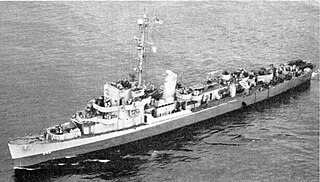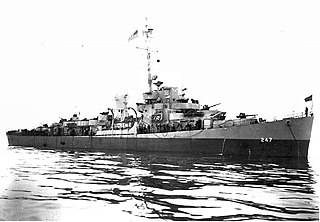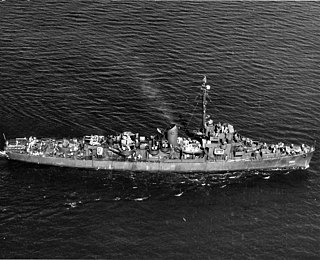
USS Breeman (DE-104) was a Cannon class destroyer escort in service with the United States Navy from 1943 to 1946. In 1948, she was sold to Taiwan, where she served as Taihu (太湖) until 1972.

USS Barr (DE-576/APD-39), originally a Buckley-class destroyer escort, and later a Charles Lawrence-class fast transport of the United States Navy named for Pvt. Woodrow Wilson Barr of Keyser, West Virginia.

USS Hubbard (DE-211/APD-53) was a Buckley-class destroyer escort in service with the United States Navy from 1944 to 1946. She was scrapped in 1966.

USS Hayter (DE-212/APD-80) was a Buckley-class destroyer escort in service with the United States Navy from 1943 to 1946. In 1967, she was transferred to South Korea where she served as ROKS Jonnam until 1986.

USS William T. Powell (DE/DER-213), a Buckley-class destroyer escort of the United States Navy, was named in honor of Gunner's Mate William T. Powell (1918-1942), who was killed in action, aboard the heavy cruiser USS San Francisco off Guadalcanal on 12 November 1942.

USS Scott (DE-214), was a Buckley-class destroyer escort in service with the United States Navy from 1943 to 1947. She was scrapped in 1967.

USS Spangenberg (DE/DER-223), a Buckley-class destroyer escort of the United States Navy, was named in honor of Gunner's Mate Kenneth J. Spangenberg (1922-1942), who died as a result of wounds suffered during the Naval Battle of Guadalcanal, while serving aboard the heavy cruiser San Francisco (CA-38). He was posthumously awarded the Navy Cross.

USS Alexander J. Luke (DE/DER-577), a Buckley-class destroyer escort of the United States Navy, was named in honor of Sergeant Alexander J. Luke (1916–1942), who was killed in action during the attack on Tulagi on 6 August 1942. He was posthumously awarded the Silver Star.

USS O'Toole (DE-527) was an Evarts-class destroyer escort of the United States Navy during World War II. She served in the North Atlantic ocean protecting convoys and other ships from German U-boats and aircraft. She also performed escort and anti-submarine operations before returning home at the end of the conflict.

USS Bostwick (DE-103) was a Cannon class destroyer escort in service with the United States Navy from 1943 to 1946. In 1948, she was sold to Taiwan where she served as Taicang (DE-25). She was scrapped in 1973.

USS Straub (DE-181) was a Cannon-class destroyer escort in service with the United States Navy from 1943 to 1947. She was sold for scrap in 1974.

USS Bronstein (DE-189) was a Cannon-class destroyer escort in service with the United States Navy from 1943 to 1945. In 1952, she was sold to Uruguay, where she served as ROU Artigas (DE-2) until being decommissioned and scrapped in 1988.

USS Baker (DE-190) was a Cannon-class destroyer escort built for the United States Navy during World War II. She served in the Atlantic Ocean and provided escort service against submarine and air attack for Navy vessels and convoys. She returned home at war's end with a one battle star for her assistance in sinking a German submarine.

USS Tomich (DE-242) was an Edsall-class destroyer escort in service with the United States Navy from 1943 to 1946. She was scrapped in 1974.

USS Sloat (DE-245) was an Edsall-class destroyer escort built for the U.S. Navy during World War II. She served in the Atlantic Ocean the Pacific Ocean and provided destroyer escort protection against submarine and air attack for Navy vessels and convoys.

USS Stanton (DE-247) was an Edsall-class destroyer escort built for the U.S. Navy during World War II. She served in the Atlantic Ocean the Pacific Ocean and provided destroyer escort protection against submarine and air attack for Navy vessels and convoys.

USS Swasey (DE-248) was an Edsall-class destroyer escort built for the U.S. Navy during World War II. She served in the Atlantic Ocean the Pacific Ocean and provided destroyer escort protection against submarine and air attack for Navy vessels and convoys.

USS Sellstrom (DE-255) was an Edsall-class destroyer escort built for the U.S. Navy during World War II. She served in the Atlantic Ocean, the Pacific Ocean and provided destroyer escort protection against submarine and air attack for Navy vessels and convoys.

USS Rhodes (DE-384) was an Edsall-class destroyer escort in service with the United States Navy from 1944 to 1946 and from 1955 to 1963. She was scrapped in 1975.

USS Cockrill (DE-398) was an Edsall-class destroyer escort in service with the United States Navy from 1943 to 1946. After spending decades in reserve, she was sunk as a target in November 1974.




















